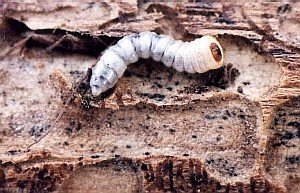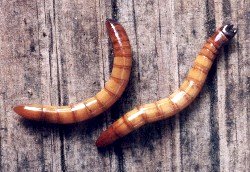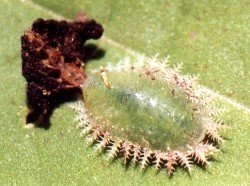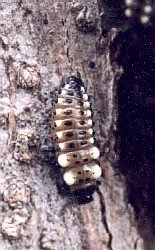The term grub usually refers to certain kinds of insect larvae. It is not a very specific moniker, but does tend to give the right impression for the kinds of creatures in this essay. Another title could have been "baby beetles." However, that conjures up pictures of something cute and cuddly, which is not the image most people have for these immature insects. The typical grub is a subterranean inhabitant of yards and gardens, usually eating the roots of plants and thereby causing gardeners and landscapers much grief. The ones usually found when digging in the soil are about an inch long and are the larvae of the June beetle, or June bug.

One interesting grub we sometimes find in our yard is the round-headed borer. This is the larva of a species of borer longhorn beetle, although I'm not sure of the exact identification. The adult is about an inch long, has incredibly long antennae, and is brown with subtle markings. In the photo at left there is an adult hiding behind the larva. This species of round-headed borer seems to only infest the wood of our dead sumacs. Being short-lived trees, the numerous sumacs in our yard are always dying, while at the same time putting out new suckers. When one of the thicker trunks has been dead for a few months, the bark will peel off, revealing the handiwork of the wood borers: an abstract artwork of gouged out tunnels covering the inner wood. These larvae don't burrow in very far, just consuming the wood right below the bark. The adults can be found in the same tunnels, but I don't know if they eat the wood as well. Because these insects cause no problem for our live plants, they are actually beneficial in breaking down the dead wood. There are related species, though, that attack live trees and can cause quite a bit of damage.
 Another subterranean dwelling larva is the wireworm. Because of its morphology, it isn't usually called a grub, but it is the larva of the click beetle. The wireworms we find in our yard range up to about two inches long. They are hard and shiny, and often wiggle like earthworms when they are exposed. I'm not sure how many plants succumb to their feasting, but they generally eat the roots of live plants and so are not desirable. Wireworms are very numerous in our yard and when the click beetles are hatching out, they often get into the house. They do no damage, and don't bite, but often get stuck in places like boxes or paper bags and their incessant clicking reveals their whereabouts. The click mechanism is a means of righting themselves when they fall on their back, which seems to be fairly often, or escaping from enemies. They snap their thorax at an angle to their abdomen with quite a bit of force, and can propel themselves into the air about a foot. Some species of click beetles are also called elaters (as anybody who works crossword puzzles knows).
Another subterranean dwelling larva is the wireworm. Because of its morphology, it isn't usually called a grub, but it is the larva of the click beetle. The wireworms we find in our yard range up to about two inches long. They are hard and shiny, and often wiggle like earthworms when they are exposed. I'm not sure how many plants succumb to their feasting, but they generally eat the roots of live plants and so are not desirable. Wireworms are very numerous in our yard and when the click beetles are hatching out, they often get into the house. They do no damage, and don't bite, but often get stuck in places like boxes or paper bags and their incessant clicking reveals their whereabouts. The click mechanism is a means of righting themselves when they fall on their back, which seems to be fairly often, or escaping from enemies. They snap their thorax at an angle to their abdomen with quite a bit of force, and can propel themselves into the air about a foot. Some species of click beetles are also called elaters (as anybody who works crossword puzzles knows).
 Some beetle larvae don't resemble the usual grubs at all. Pictured at left is a small insect called a tortoise beetle. The name comes from the physical appearance of the adults, which look like round beetles with clear plastic covers over their entire bodies. They are sometimes called gold beetles because of the metallic sheen produced by their carapace. Only the live insects have the pretty color and it disappears when they die. When they are disturbed, they hold on tight to the surface and pull their umbrella-like shell down on all sides, similar to the defensive posture of a chiton or limpet. It is rather difficult to dislodge them because their outer shell is so smooth. The larva is just about ¼ inch long and was feeding on a young jimsonweed plant. It did quite a bit of damage to the leaves, producing large holes in many different places. The brown mass is attached to the posterior end of the insect and consists of feces, molted skins, and silk. It is hard and the larva usually carries it up and over its back, probably for protection and camouflage. I pulled it a bit and it let it fall backwards, but it did not come off and seems to be held on to its tail quite securely. This larva could be mistaken for a caterpillar of some kind, because of its feeding habits and strange shape.
Some beetle larvae don't resemble the usual grubs at all. Pictured at left is a small insect called a tortoise beetle. The name comes from the physical appearance of the adults, which look like round beetles with clear plastic covers over their entire bodies. They are sometimes called gold beetles because of the metallic sheen produced by their carapace. Only the live insects have the pretty color and it disappears when they die. When they are disturbed, they hold on tight to the surface and pull their umbrella-like shell down on all sides, similar to the defensive posture of a chiton or limpet. It is rather difficult to dislodge them because their outer shell is so smooth. The larva is just about ¼ inch long and was feeding on a young jimsonweed plant. It did quite a bit of damage to the leaves, producing large holes in many different places. The brown mass is attached to the posterior end of the insect and consists of feces, molted skins, and silk. It is hard and the larva usually carries it up and over its back, probably for protection and camouflage. I pulled it a bit and it let it fall backwards, but it did not come off and seems to be held on to its tail quite securely. This larva could be mistaken for a caterpillar of some kind, because of its feeding habits and strange shape.

The next creature pictured appeared in a very dramatic way. We found hundreds of these immature insects climbing down the bark of a willow tree in our yard one day. They ranged from quite tiny to over ½ inch in length, and looked something like the larvae of ladybird beetles, but certainly not any species I've ever seen. In fact, they were the larvae of cottonwood leaf beetles and were descending the tree in order to pupate. These insects eat the leaves of trees such as cottonwood, poplar, and willow. The larvae mature quickly and there can be several generations each year in our area. Because our willow is so tall and the crown is obscured by the foliage of other nearby trees, we never noticed any damage to the leaves. The tree never seems very healthy, often losing small branches, but we thought it was because we don't provide it with enough water. Perhaps the added stress of defoliation every so often is contributing to its rather weak growth.
 The final insect shown is a classic example of a grub. We find these huge creatures in the lower parts of our compost bins, where they feed on decaying wood. These grubs belong to the scarab family, which includes the world's largest beetles, as well as such pests as the Japanese beetle and rose chafer, and curiosities like the tumble bugs. They are the larvae of ox beetles, which are big, shiny and dark brown. The females sometimes show up around the bins, obviously to find a good site in which to lay eggs. The larvae take at least two years to mature, as wood is not a particularly nutritious diet. For somebody used to digging up the little inch long June bug grubs, finding these monsters is always quite a surprise.
The final insect shown is a classic example of a grub. We find these huge creatures in the lower parts of our compost bins, where they feed on decaying wood. These grubs belong to the scarab family, which includes the world's largest beetles, as well as such pests as the Japanese beetle and rose chafer, and curiosities like the tumble bugs. They are the larvae of ox beetles, which are big, shiny and dark brown. The females sometimes show up around the bins, obviously to find a good site in which to lay eggs. The larvae take at least two years to mature, as wood is not a particularly nutritious diet. For somebody used to digging up the little inch long June bug grubs, finding these monsters is always quite a surprise.
|

 Another subterranean dwelling larva is the wireworm. Because of its morphology, it isn't usually called a grub, but it is the larva of the click beetle. The wireworms we find in our yard range up to about two inches long. They are hard and shiny, and often wiggle like earthworms when they are exposed. I'm not sure how many plants succumb to their feasting, but they generally eat the roots of live plants and so are not desirable. Wireworms are very numerous in our yard and when the click beetles are hatching out, they often get into the house. They do no damage, and don't bite, but often get stuck in places like boxes or paper bags and their incessant clicking reveals their whereabouts. The click mechanism is a means of righting themselves when they fall on their back, which seems to be fairly often, or escaping from enemies. They snap their thorax at an angle to their abdomen with quite a bit of force, and can propel themselves into the air about a foot. Some species of click beetles are also called elaters (as anybody who works crossword puzzles knows).
Another subterranean dwelling larva is the wireworm. Because of its morphology, it isn't usually called a grub, but it is the larva of the click beetle. The wireworms we find in our yard range up to about two inches long. They are hard and shiny, and often wiggle like earthworms when they are exposed. I'm not sure how many plants succumb to their feasting, but they generally eat the roots of live plants and so are not desirable. Wireworms are very numerous in our yard and when the click beetles are hatching out, they often get into the house. They do no damage, and don't bite, but often get stuck in places like boxes or paper bags and their incessant clicking reveals their whereabouts. The click mechanism is a means of righting themselves when they fall on their back, which seems to be fairly often, or escaping from enemies. They snap their thorax at an angle to their abdomen with quite a bit of force, and can propel themselves into the air about a foot. Some species of click beetles are also called elaters (as anybody who works crossword puzzles knows).
 Some beetle larvae don't resemble the usual grubs at all. Pictured at left is a small insect called a tortoise beetle. The name comes from the physical appearance of the adults, which look like round beetles with clear plastic covers over their entire bodies. They are sometimes called gold beetles because of the metallic sheen produced by their carapace. Only the live insects have the pretty color and it disappears when they die. When they are disturbed, they hold on tight to the surface and pull their umbrella-like shell down on all sides, similar to the defensive posture of a chiton or limpet. It is rather difficult to dislodge them because their outer shell is so smooth. The larva is just about ¼ inch long and was feeding on a young jimsonweed plant. It did quite a bit of damage to the leaves, producing large holes in many different places. The brown mass is attached to the posterior end of the insect and consists of feces, molted skins, and silk. It is hard and the larva usually carries it up and over its back, probably for protection and camouflage. I pulled it a bit and it let it fall backwards, but it did not come off and seems to be held on to its tail quite securely. This larva could be mistaken for a caterpillar of some kind, because of its feeding habits and strange shape.
Some beetle larvae don't resemble the usual grubs at all. Pictured at left is a small insect called a tortoise beetle. The name comes from the physical appearance of the adults, which look like round beetles with clear plastic covers over their entire bodies. They are sometimes called gold beetles because of the metallic sheen produced by their carapace. Only the live insects have the pretty color and it disappears when they die. When they are disturbed, they hold on tight to the surface and pull their umbrella-like shell down on all sides, similar to the defensive posture of a chiton or limpet. It is rather difficult to dislodge them because their outer shell is so smooth. The larva is just about ¼ inch long and was feeding on a young jimsonweed plant. It did quite a bit of damage to the leaves, producing large holes in many different places. The brown mass is attached to the posterior end of the insect and consists of feces, molted skins, and silk. It is hard and the larva usually carries it up and over its back, probably for protection and camouflage. I pulled it a bit and it let it fall backwards, but it did not come off and seems to be held on to its tail quite securely. This larva could be mistaken for a caterpillar of some kind, because of its feeding habits and strange shape.

 The final insect shown is a classic example of a grub. We find these huge creatures in the lower parts of our compost bins, where they feed on decaying wood. These grubs belong to the scarab family, which includes the world's largest beetles, as well as such pests as the Japanese beetle and rose chafer, and curiosities like the tumble bugs. They are the larvae of ox beetles, which are big, shiny and dark brown. The females sometimes show up around the bins, obviously to find a good site in which to lay eggs. The larvae take at least two years to mature, as wood is not a particularly nutritious diet. For somebody used to digging up the little inch long June bug grubs, finding these monsters is always quite a surprise.
The final insect shown is a classic example of a grub. We find these huge creatures in the lower parts of our compost bins, where they feed on decaying wood. These grubs belong to the scarab family, which includes the world's largest beetles, as well as such pests as the Japanese beetle and rose chafer, and curiosities like the tumble bugs. They are the larvae of ox beetles, which are big, shiny and dark brown. The females sometimes show up around the bins, obviously to find a good site in which to lay eggs. The larvae take at least two years to mature, as wood is not a particularly nutritious diet. For somebody used to digging up the little inch long June bug grubs, finding these monsters is always quite a surprise.